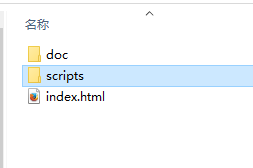首先,目录如下(根目录有一个index.html文件、有一个scripts文件夹):

scripts文件夹有如下的文件

以下是index.html代码

1 <!DOCTYPE html> 2 <html> 3 <head> 4 <title>My Sample Project</title> 5 <!-- data-main attribute tells require.js to load 6 scripts/main.js after require.js loads. --> 7 <script data-main="scripts/main" src="scripts/require.js"></script> 8 </head> 9 <body> 10 <h1>My Sample Project</h1> 11 </body> 12 </html>
RequireJS的目标是鼓励代码的模块化,它使用了不同于传统<script>标签的脚本加载步骤。可以用它来加速、优化代码,但其主要目的还是为了代码的模块化。它鼓励在使用脚本时以module ID替代URL地址。
RequireJS以一个相对于baseUrl的地址来加载所有的代码。 页面顶层<script>标签含有一个特殊的属性data-main,require.js使用它来启动脚本加载过程,而baseUrl一般设置到与该属性相一致的目录。下列示例中展示了baseUrl的设置:
<!--This sets the baseUrl to the "scripts" directory, and
loads a script that will have a module ID of 'main'-->
<script data-main="scripts/main.js" src="scripts/require.js"></script>
baseUrl亦可通过RequireJS config手动设置。如果没有显式指定config及data-main,则默认的baseUrl为包含RequireJS的那个HTML页面的所属目录。
RequireJS默认假定所有的依赖资源都是js脚本,因此无需在module ID上再加".js"后缀,RequireJS在进行module ID到path的解析时会自动补上后缀。你可以通过paths config设置一组脚本,这些有助于我们在使用脚本时码更少的字。
有时候你想避开"baseUrl + paths"的解析过程,而是直接指定加载某一个目录下的脚本。此时可以这样做:如果一个module ID符合下述规则之一,其ID解析会避开常规的"baseUrl + paths"配置,而是直接将其加载为一个相对于当前HTML文档的脚本:
- 以 ".js" 结束.
- 以 "/" 开始.
- 包含 URL 协议, 如 "http:" or "https:".
在main.js中有如下代码:
alert(123);
在浏览器中浏览查看index.html

另一种方式是在引入require.js时不设置data-main,后面通过代码形式装载:

<!DOCTYPE html> <html> <head> <title>My Sample Project</title> <!-- data-main attribute tells require.js to load scripts/main.js after require.js loads. --> <!--data-main="scripts/main" --> <script src="scripts/require.js"></script> <script type="text/javascript"> require(['scripts/main.js'],function(){}); </script> </head> <body> <h1>My Sample Project</h1> </body> </html>
该代码可以达到同样的效果
参考资料:
